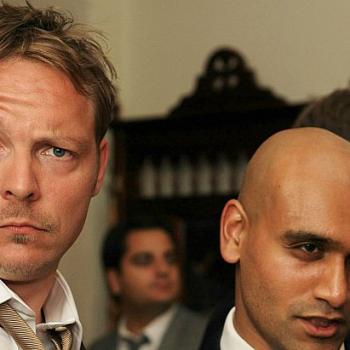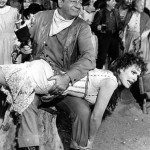A Review Series of Anonymous Tip, by Michael Farris
Pp. 453-456
Okay, Supreme Court day!
Peter looked at Gwen and said, “You look like a 9-to-nothing ruling in that suit. I’m so glad you’re here with me.”
Do we have to do this? SERIOUSLY.
Oh no. Before they start, we get this:
A huge statue of John Marshall, in sitting position, loomed in front of them down he marble hallway. The statue depicted him with only a copy of the Constitution and a quill pen in his hands. “That’s misleading,” Peter said as he paused to look at the statue.
“What are you referring to?” asked Gwen.
“Well, from that statue you get the idea that the Constitution was the most important thing in Marshall’s life, but that’s not true. The Bible was the most important thing in Marshall’s life. He believed it was the foundation of the Constitution, without which we couldn’t govern this country.”
John Marshall was chief justice of the Supreme Court from 1801 to 1835 and played a big part in shaping the role of the court. I am assuming this is the statue described:

I spent quite some time googling Farris’s claim about Marshall, but I couldn’t find anything about it at all. The only thing I found about Marshall’s religion is that he was an Episcopalian. I didn’t find any quotes on religion by him, except for this one, which appears to be wrong, because I looked up the newspaper referenced and the only letter there to a Rev. J. Adams was written by James Madison, not by Marshall, and to top it off it didn’t include that quote anyway.
This doesn’t mean Farris is wrong, necessarily, but it does make me skeptical.
And now the hearing begins. Peter goes first. Do social workers have to follow the fourth amendment? Are social workers immune from lawsuits? What about lawsuits concerning deliberate fraud? I’m not going to type this out in full, because reasons. Peter does sneak some of his new arguments in, noting briefly, for instance, that “we have demonstrated fraud by government officials before, during, and after the trial had been completed.” This was the first time he’d noted that the fraud wasn’t only committed during the case, but also after it. Farris tells us Peter’s words were “carefully scripted with the professor’s help and memorized.”
When Justice Kraus asks why their concerned about fourth amendment rights when they’re just suing for damages, Peter says that “our complaint also seeks a declaratory judgement asking for a ruling that it is unconstitutional to enter a home for a child abuse investigation whens the only cause for the visit is an anonymous tip on a hotline.” This is something Farris has been pushing through HSLDA, down to arguing cases on it himself. I am not a lawyer, but I’m curious why he frames preventing social workers from making contact with your children as a fourth amendment issue; children are not property.
Justice Geisler cites “the epidemic of child abuse that is obviously going on in this nation” and asks whether, in that light, allowing social workers more leeway makes sense “if our goal is to protect children.” I suppose Supreme Court justices aren’t necessarily experts in things like the history of child abuse, but the phrasing still bothers me; child abuse has always occurred, what has changed is not its incidence but rather our awareness and acceptance of it.
Oh wait. Wait wait. This happens:
“Your Honor, I have two replies. First, the Constitution is applicable at all times and in all circumstances. We have always had child abuse in this country—”
“At this level?” Geisler interjected.
“No, Your Honor, we are a much larger country and our moral condition has indeed declined. But the incidence of child-abuse that is presumed to be an epidemic is grossly over-inflated by the inclusion of demonstrably false cases into the record. Accordingly [sic] to a well-known children’s rights organization, over 60% of the claimed two million cases of claimed child-abuse are unfounded.”
*headdesk*
There is actually good reason to believe that child abuse occurred at a much higher level in the past than it does in the present. There were at one time no laws against child abuse, because parents beating their children was seen as normative. Parental control (and parental cruelty) was just a fact of life. In fact, many scholars believe reformers were only able to gain attention for the first child abuse case in which civil authorities intervened—a case where a girl was being severely beaten, starved, and locked in a closet—because the child was living with adoptive parents rather than her biological parents. If it had been the girl’s biological parents, it is more than possible that the public wouldn’t have blinked.
As Lela B. Costin notes in her article, Unraveling the Mary Ellen Legend:
Cruelty to children had long been tolerated and suppressed. Why then did the Mary Ellen case serve to stimulate court intervention and a widespread philanthropic response? Clearly the answer is not the severity of the cruel treatment. Earlier in the same year, the New York Times reported that John Fox, 13, had died from a cruel beating by his father for “refusing to go after beer without the money to pay for it.” A coroner’s inquest revealed that the child had died of pleuro- pneumonia caused by injuries inflicted by his father. No further attention was given to the case in the Times.
. . .
Mary Ellen was an illegitimate child and beaten by someone other than her natural parents, a circumstance that muted the old precept of a parent’s right to determine the nature and severity of a child’s punishment. Interfering with cruel treatment of this particular child did not violate the privacy of family life; Mary Ellen did not live in a proper family. Public outrage about the abuse and compassion for the child was acceptable. Willingness to exclude cruelty to children from public consciousness was reduced.
The only reason people many people (including both Peter and Justice Geisler in our story) believe the rate of child abuse has gone up in recent decades is that our tolerance for child abuse has decreased and our awareness has increased. This really is 101 level stuff for anyone studying children’s issues. It’s not a secret.
Also, no one denies that 60% of reports made to child abuse hotlines are determined to be unfounded. I’m not sure why Farris thinks that such a bad thing, either—it shoes that the system works, that social workers investigate whether or not abuse is present rather than assuming that a tip to a hotline implies automatic guilt. This rather operates against his arguments, not for them.
Also, if there are two million reports each year, and 60% are founded, that’s 1.2 million founded cases of child abuse each year. I’m not sure why Farris thinks that makes it sound like it’s not a problem! That’s still a huge number—and it only contains cases that are noticed, reported, screened in, and successfully identified by investigators! Peter claims Casey is now included in child abuse statistics, but that’s simply not the case—any serious children’s rights advocate knows the difference between reports and founded cases and makes that distinction when working to raise awareness of that problem. None of this makes sense.
Still, Farris goes on:
“The only abuse this four-year old [sic] suffered was at the hands of the two state-employed CPS investigators who took her into her bedroom without her mother, closed the door, and strip-searched her. Every child who is traumatized in this way has been unnecessarily abused. The fastest way this court could dramatically protect children from unnecessary abuse is to rule that the strip search of Casey Landis was unconstitutional. Hundreds of thousands of children would be protected in the first year if this Court would simply say to the nation’s social workers, ‘Get some proper evidence and go have a five minute visit with a judge before you barge into a home in a non-emergency situation.'”
So there are actually two things going on here. I absolutely agree that there have to be standards social workers follow when interacting with children, and there are. I’m not sure what the standards were when this book was published, but I know social workers who have read this series and commented said back at the beginning of the book that what Donna and Rita did to Casey was absolutely inappropriate. But there’s a difference between saying social workers need to be trained in how to assess children’s safety without traumatizing them, on the one hand, and saying that we should limit social workers’ access to children, on the other.
It is not always possible to get additional evidence, especially when a tip involves the inside of a house, or the child’s safety in the home. A social worker could canvas the neighbors, I suppose, but if I had a penny for every child abuse case I’ve read about where the neighbors say, after the fact, that they had no idea any of that was going on, I’d be rich. I should also note that reports that lack sufficient information or have to do with things that are legal (simple spanking, say) are already screened out and aren’t handed on to investigators. Those that are investigated are ones that seemed credible only.
The problem I have here is that while Farris is claiming to speak for Casey’s wellbeing, he’s really not. He’s not simply asking the justices to require that social workers be trained in interacting properly with children so that they’re not traumatized; he’s asking the justices to bar social workers from entering a home and seeing a child until they already have enough proof to set before a judge that abuse is occurring when the point of the investigation is to get that proof. This is not speaking for children’s wellbeing. It’s speaking for parents’ ability to control who has access to their children and their children’s living environment when a tip is made alleging child abuse or neglect.
But according to Farris, Peter’s words were effective. Justice Geisler was taken aback—he demanded to know whether this information is in the record, and Peter said it was gave him the page number—and for his part, Justice Rose was “smiling slyly as he took notes.”
We’re going to have to stop here though, because I’m out of time.
I have a Patreon! Please support my writing!















